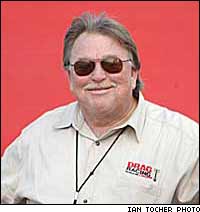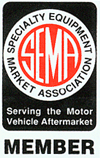|
|||||||||||||||||||||||||||||||||||||||||||||||||||||||||||||

Editor’s notes from a six-week road trip
11/8/06
 Photo by Ian Tocher |
Here are some notes scribbled on airline boarding passes.
IHRA AND PRO MODS
No nitrous cars qualified for Pro Mod at the season-ending IHRA World Finals at Steve Earwood’s Rockingham Dragway so there can be little doubt that the IHRA rules makers will be forced to make some serious adjustments for IHRA supercharged Pro Mods.
I’m told that after Rockingham IHRA officials told some tuners and drivers of supercharged Pro Mod cars racers that a yet to be determined overdrive reduction (15% overdrive or lower), a ban of both the two-step launch rev limiter and electronic timing controls, and a reduction of the maximum gear rear-end ratio from the now mandatory 4.56 to 4.30 were seriously being considered as rule changes to “level” the playing field for supercharged and nitrous oxide injected IHRA Pro Mods. Other rule changes being discussed include making a “stock” supercharger case mandatory or a “restrictor” plate under the supercharger to reduce air volume.
On the other side, the nitrous cars supposedly are going to be able to build much larger engines with cubic inch displacement in the same area as IHRA allows for their Pro Stock division where there are virtually no performance restrictions for nitrous cars -– and rightfully so.
Here’s my prediction based upon 16 years or observing the class and working with both nitrous and supercharged teams. Allowing those changes will only accomplish one thing: It will make a class already expensive to compete in that much more expensive, drive a few more teams away from IHRA Pro Mod, and will not keep the supercharged teams that are dominant now from continuing to be dominant.
There are already very quick cars that don’t use electronic timing retard or two-step rev limiters. I hear that some of the supercharged cars are already using a 4.30 gear and every time -- EVERY TIME -- the rules guys have taken supercharger overdrive away the cars that use them have gone quicker and faster. That is a fact.
There are really only two solutions here: separate the two classes or cripple the supercharged cars with rule changes so drastic they can’t spend enough time or money to overcome them. Whichever course the IHRA chooses, they should make the announcement soon. As I write this the PRI Show is a bit over a month away and there are less than 60 days until 2007! If racers need to make changes to their cars for next season, they need to know it now.
KEEPING INNOVATION ALIVE
There are just three racing organizations left that reward the innovative, out of the box, tuners, engine-builders and racers: the SCTA which sanctions speed trials on the Bonneville Salt Flats, any sand drag racing association, and the eighth-mile American Drag Racing League. At events put on by those sanctioning bodies they don’t ask how, they just ask how fast. I highly recommend attending any races those organizations put on if you want to see bare-knuckles, pure racing instead of the kind where often the fastest racers get punished instead of rewarded.
JIM ODDY RETIRES
I’d known it was going to happen for some time but nevertheless the fact that Pro Mod icon and my good friend Jim Oddy followed his former driver Fred Hahn into retirement from drag racing after the IHRA national event at Rockingham left me a little sad. I’ve been Jim Oddy’s PR guy and friend since 1992 and during that time he and long-time driver Fred Hahn won national championships in every sanctioning body that had a Pro Mod class in the U.S. and Canada, including the IHRA and NHRA titles. Jimmy retired in style with his car and driver Steve Bareman setting the IHRA Pro Mod speed record at 238.93 mph at the next to last IHRA race of the season at Maryland International Raceway -- thanks at least in part to his co-tuners and twin sons Dave and Dan.
That speed record may stand for a long time. Pro Mod won’t be the same for me without a Jim Oddy car at the races. All my PR clients are retiring or quitting. It must be some kind of sign.
ON THE ROAD AGAIN?
I’ve never had more respect for drag racing’s traveling teams than I do right now. I’ve been on the road eating White Castle sliders and staying at motels almost every weekend since the U.S. Nationals and I am freakin’ fried! I honestly don’t know how the crews that race or test 25-35 weeks a year do it and keep on doing it year after year. You talk about superb athletes, the men and women on professional drag racing teams surely are. Plus they have the constitution of a badger. At the end of my six weeks on the road I needed to send my stomach in for an overhaul, my liver to the Betty Ford for detox and my credit card to intensive care. No mas!
BILLET NITROUS PROGRESS
Watching Steve Kirk Jr. qualifying his Outlaw Ten-wide Camaro using a Gene Fulton-built, 880 cubic inch “wedge-headed” motor under the hood equipped with multiple stages of nitrous at the recently completed World Street Nationals made me think of the time not so long ago when nitrous racers all swore that 615 cubic inch engines were as big an engine as they could build, make good horsepower using nitrous oxide injection and not blow their stuff up. That weekend at Orlando I saw many cars with multiple stages of nitrous that were between 737 cubic inches and 870 cubic inches in displacement and none blew up. I guess there is still no substitute for billet blocks, cylinder heads, cranks and rods – and money.
FANS KNOW WHAT THEY LIKE
Races like the ADRL’s Dragstock III at Rockingham and the World Street Nationals at Orlando are proof that race fans will turn out in droves and put up with a lot to watch fast doorslammers race if you give them some variety of body style, powerplants, and looks. They’ll even buy a relatively expensive ticket ($30 per day at the WSCF) but they have to get an entertaining, somewhat unique experience. It appears to me that the problem is that many promoters and sanctioning body execs don’t take the time to personally talk to their customers (without wearing official apparel) to find out what they really think.
I’m really tired of professional drag race drivers telling me what their fans like and don’t like about drag racing. Have you noticed how few of them spend any time in the grandstands watching racing when they aren’t competing? Most will tell you they are bad spectators and can’t bear to sit in the grandstands and watch someone else race. I say make all of them sit through an entire professional or sportsman qualifying session either on the tube or in person and then decide what the average fan knows, likes, or dislikes about the sport. When you have the best seat in the house (in the car) or only talk to people seeking an autograph it’s hard to really understand the fan’s problems or issues.
|
HEAD COUNT
Anyone who really believes that most of drag racing’s national event venues’ grandstands are filled (like sanctioning body PR flacks claim) should buy a TiVo, tape the races and take a closer look at the grandstands. Or better yet, leave the starting line and walk down about 600 feet and look at the stands. A different perspective really does make a difference.
ONE LAST THOUGHT
After a six-week road trip I’m encouraged and grateful to discover that there is so much good drag racing to watch and participate in all across the country. The U.S. Nationals, the IHRA events in New England and Maryland, the ADRL races at Rockingham and Ft. Worth, the sand drags in California and Nevada, and the World Street Nationals at Orlando all were extremely entertaining and unique in their own way. The racers at each event I attended were (for the most part) completely uninterested in racing “politics,” they just wanted to race. Sadly the same can’t be said for the promoters and sanctioning body heads. For them racing often takes a back seat to inter-sanctioning body politics, bickering, turf defense, and manufactured hype. Independent races have proven that drag racing can be a seriously successful spectator sport without hype, if it is properly presented and packaged. And the made for TV show “Pinks” isn’t what I’m talking about.![]()


